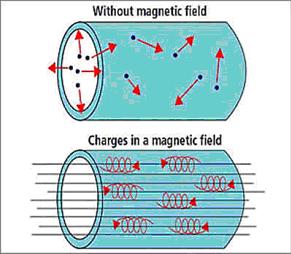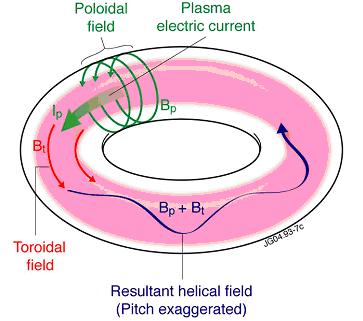Many different schemes to realized controlled fusion have been investigated. So far, magnet and inertia confinement schemes appear to be the most promising ones. Within each of the confinement schemes, there are also difference types of fusion confinement configurations (i.e., device types).
Because of the electric charges carried by electrons and ions (the ionized fuel), a plasma can be confined by a magnetic field. In the absence of a magnetic field, the charged particles move in straight lines and random directions. With no restrictions to their motion, the charged particles can strike the walls of a containing vessel, thereby cooling the plasma and inhibiting fusion reactions. The presence of a magnetic field forces the particles spiral around the field lines. Consequently, the charged particles are confined by the magnetic field and prevented from striking the vessel walls as depicted in the diagramme below. The particles, however, can move freely along the magnetic field lines.

Source: http://www.jet.efda.org/images/fusion-basics/magconfinement-s.jpg
There are two principal magnetic configurations to stop the end losses:
1. Open Trap - the magnetic field lines enter and leave the region where the plasma resides. Such a field would hinder ions and electrons from being lost radially, but not along the field lines. A magnetic mirror geometry is incorporated to stop the end losses.
2. Close Trap – the plasma occupies a toroidal magnetic field geometry. In this configuration, the field lines bend around to close on themselves thereby eliminate the losses. A simple toroidal field, however, provides poor confinement because the radial gradient of the field strength results in a plasma drift radially out of the torus.
In the early days, a number of different confinement configurations were tried out. Initial investigations were on linear devices, but loss of particles from the ends of these machines quickly led to experiments which wrapped the field round to form a torus. The field variation of a simple toroidal field results in a plasma drift and hence losses. The situation is improved with a helical field configuration and one of the most successful configurations is the ‘tokamak’.
In a tokamak, the plasma is driven to carry a current circulating the toroidal chamber. This plasma current provides a component of poloidal field in the plasma in addition to the externally applied toroidal field. The resultant fields spiral round to form a helical field configuration. Particles orbiting the field line are constrained near this surface, unless they collide with other particles. There are also "poloidal field coils" that generate a vertical field which interact with the plasma current to produce a radially inwards force on the plasma ring. The poloidal field coils are used to add beneficial shaping to the plasma minor cross section (stretching it vertically), and to generate channels for particle and energy exhaust.

Source: www.tpg.efda.org/hcd/index.htm
Research on magnetic confinement has further been conducted on a number of other configurations, such as the stellarator, where the magnetic field is almost entirely generated by external current sources, and the reversed field pinch where a larger portion of the magnetic field is due to the plasma currents than that in a tokamak.